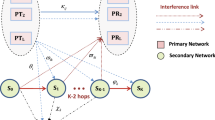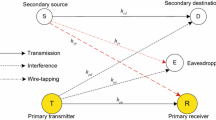Abstract
Cognitive heterogeneous cellular networks (CHCNs) are emerging as a promising approach to next-generation wireless communications owing to their seamless coverage and high network throughput. In this paper, we describe our reliance on multi-antenna technology and a secrecy transmission protocol to ensure the reliability and security of downlink underlay CHCNs. First, we introduce a two-tier CHCN model using a stochastic geometry framework, and derive the probability distribution of the indicator function for a secrecy transmission scheme. We then investigate the connection outage probability, secrecy outage probability (SOP), and transmission SOP of both primary and cognitive users under a secrecy guard scheme and a threshold-based scheme. Furthermore, we reveal some insights into the secrecy performance by properly setting the predetermined access threshold and the radius of detection region for the secrecy transmission scheme. Finally, simulation results are provided to show the influence of the antenna system, eavesdropper density, predetermined access threshold, and radius of the detection region on the reliability and security performance of a CHCN.
Similar content being viewed by others
References
Li B, Fei Z S, Chen H. Robust artificial noise-aided secure beamforming in wireless-powered non-regenerative relay. IEEE Access, 2016, 4: 7921–7929
Yang N, Wang L, Geraci G, et al. Safeguarding 5G wireless communication networks using physical layer security. IEEE Commun Mag, 2015, 53: 20–27
Li B, Fei Z S. Probabilistic-constrained robust secure transmission for energy harvesting over MISO channels. Sci China Inf Sci, 2018, 61: 022303
Andrews J, Claussen H, Dohler M, et al. Femtocells: past, present, and future. IEEE J Sel Areas Commun, 2012, 30: 497–508
Li B, Fei Z S, Chu Z, et al. Secure transmission for heterogeneous cellular networks with wireless information and power transfer. IEEE Syst J, 2017. doi: 10.1109/JSYST.2017.2713881
Zou Y, Yao Y D, Zheng B. Cooperative relay techniques for cognitive radio systems: spectrum sensing and secondary user transmissions. IEEE Commun Mag, 2012, 50: 98–503
Xu X, He B, Yang W, et al. Secure transmission design for cognitive radio networks with poisson distributed eavesdroppers. IEEE Trans Inf Forensic Secur, 2015, 11: 373–387
Zou Y, Zhu J, Yang L, et al. Securing physical-layer communications for cognitive radio networks. IEEE Commun Mag, 2015, 53: 48–54
Li B, Fei Z S. Robust beamforming and cooperative jamming for secure transmission in DF relay systems. EURASIP J Wirel Commun Netw, 2016, 68: 1–11
Li X Y, Jin L, Huang K Z, et al. Transmission frequency-band hidden technology in physical layer security. Sci China Inf Sci, 2016, 59: 019301
Gong S Q, Xing C W, Fei Z S, et al. Cooperative beamforming design for physical-layer security of multi-hop MIMO communications. Sci China Inf Sci, 2016, 59: 062304
Zhong B, Wu M G, Li T, et al. Physical layer security via maximal ratio combining and relay selection over Rayleigh fading channels. Sci China Inf Sci, 2016, 59: 062305
Zou Y, Champagne B, Zhu W P, et al. Relay-selection improves the security-reliability trade-off in cognitive radio systems. IEEE Trans Commun, 2015, 63: 215–228
Mokari N, Parsaeefard S, Saeedi H, et al. Secure robust ergodic uplink resource allocation in relay-assisted cognitive radio networks. IEEE Trans Signal Proc, 2015, 63: 291–304
Wang C, Wang H M. On the secrecy throughput maximization for MISO cognitive radio network in slow fading channels. IEEE Trans Inf Forensic Secur, 2014, 9: 1814–1827
Zou Y, Wang X, Shen W. Physical-layer security with multiuser scheduling in cognitive radio networks. IEEE Trans Commun, 2013, 61: 5103–5113
Zheng T X, Wang H M, Yuan J, et al. Multi-antenna transmission with artificial noise against randomly distributed eavesdroppers. IEEE Trans Commun, 2015, 63: 4347–4362
Wang C, Wang H M, Xia X G, et al. Uncoordinated jammer selection for securing SIMOME wiretap channels: a stochastic geometry approach. IEEE Trans Wirel Commun, 2015, 14: 2596–2612
Wang H M, Wang C, Zheng T X, et al. Impact of artificial noise on cellular networks: a stochastic geometry approach. IEEE Trans Wirel Commun, 2016, 15: 7390–7404
Wang H M, Zheng T X, Yuan J, et al. Physical layer security in heterogeneous cellular networks. IEEE Trans Commun, 2016, 64: 1204–1219
Shu Z H, Yang Y Q, Qian Y, et al. Impact of interference on secrecy capacity in a cognitive radio network. In: Proceedings of IEEE Global Telecommunications Conference, Kathmandu, 2011
Deng Y, Wang L, Zaidi S A R, et al. Artificial-noise aided secure transmission in large scale spectrum sharing networks. IEEE Trans Commun, 2016, 64: 2116–2129
Xu X, Yang W, Cai Y, et al. On the secure spectral-energy efficiency tradeoff in random cognitive radio networks. IEEE J Sel Areas Commun, 2016, 34: 2706–2722
Panahi F H, Ohtsuki T. Stochastic geometry based analytical modeling of cognitive heterogeneous cellular networks. In: Proceedings of IEEE International Conference on Communications, Sydney, 2014. 5281–5286
Blaszczyszyn B, Karray M K, Keeler H P. Using poisson processes to model lattice cellular networks. In: Proceedings of IEEE INFOCOM, Turin, 2013. 773–781
Taylor D B, Dhillon H S, Novlan T D, et al. Pairwise interaction processes for modeling cellular network topology. In: Proceedings of IEEE Global Communications Conference, Anaheim, 2012. 4524–4529
Dhillon H S, Ganti R K, Baccelli F, et al. Modeling and analysis of K-tier downlink heterogeneous cellular networks. IEEE J Sel Areas Commun, 2012, 30: 550–560
Deng Y S, Wang L F, Wong K K, et al. Safeguarding massive MIMO aided hetnets using physical layer security. In: Proceedings of IEEE International Conference on Wireless Communications & Signal Processing, Nanjing, 2015. 1–5
Wang H, Zhou X, Reed M C. Physical layer security in cellular networks: a stochastic geometry approach. IEEE Trans Wirel Commun, 2013, 12: 2776–2787
Wu H, Tao X, Li N, et al. Secrecy outage probability in multi-RAT heterogeneous networks. IEEE Commun Lett, 2016, 20: 53–56
Gupta A K, Dhillon H S, Vishwanath S, et al. Downlink coverage probability in MIMO HetNets with flexible cell selection. In: Proceedings of IEEE Global Communications Conference, Austin, 2014. 1534–1539
Acknowledgements
This work was supported by National Natural Science Foundation of China (Grant Nos. 61401510, 61379006, 61601514, 61521003), National High Technology Research and Development Program of China (863) (Grant No. 2015AA01A708).
Author information
Authors and Affiliations
Corresponding author
Rights and permissions
About this article
Cite this article
Qi, X., Huang, K., Li, B. et al. Physical layer security in multi-antenna cognitive heterogeneous cellular networks: a unified secrecy performance analysis. Sci. China Inf. Sci. 61, 022310 (2018). https://doi.org/10.1007/s11432-016-9149-4
Received:
Revised:
Accepted:
Published:
DOI: https://doi.org/10.1007/s11432-016-9149-4




